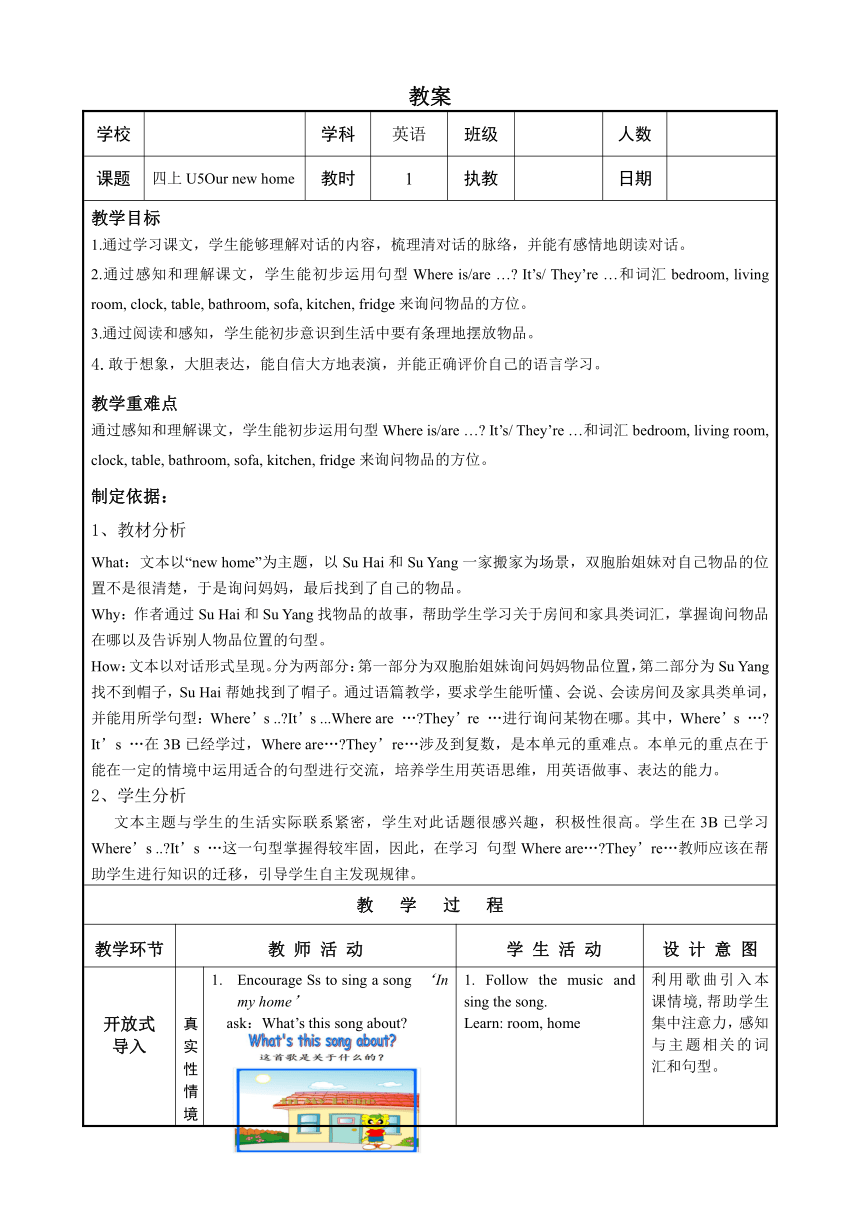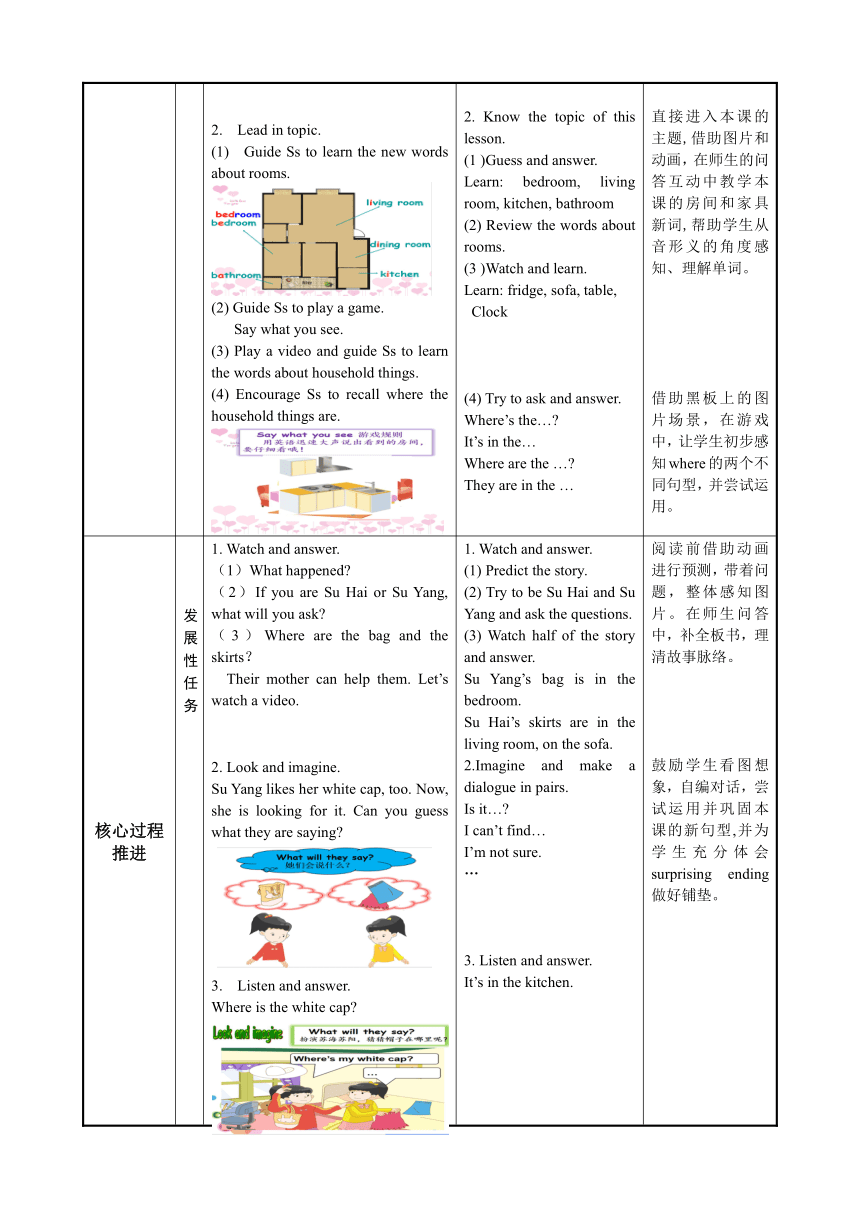Unit 5 Our new home 第一课时表格式教案
文档属性
| 名称 | Unit 5 Our new home 第一课时表格式教案 |

|
|
| 格式 | docx | ||
| 文件大小 | 3.8MB | ||
| 资源类型 | 教案 | ||
| 版本资源 | 牛津译林版 | ||
| 科目 | 英语 | ||
| 更新时间 | 2024-09-14 16:48:38 | ||
图片预览


文档简介
教案
学校 学科 英语 班级 人数
课题 四上U5Our new home 教时 1 执教 日期
教学目标 1.通过学习课文,学生能够理解对话的内容,梳理清对话的脉络,并能有感情地朗读对话。 2.通过感知和理解课文,学生能初步运用句型Where is/are … It’s/ They’re …和词汇bedroom, living room, clock, table, bathroom, sofa, kitchen, fridge来询问物品的方位。 3.通过阅读和感知,学生能初步意识到生活中要有条理地摆放物品。 4.敢于想象,大胆表达,能自信大方地表演,并能正确评价自己的语言学习。 教学重难点 通过感知和理解课文,学生能初步运用句型Where is/are … It’s/ They’re …和词汇bedroom, living room, clock, table, bathroom, sofa, kitchen, fridge来询问物品的方位。 制定依据: 1、教材分析 What:文本以“new home”为主题,以Su Hai和Su Yang一家搬家为场景,双胞胎姐妹对自己物品的位置不是很清楚,于是询问妈妈,最后找到了自己的物品。 Why:作者通过Su Hai和Su Yang找物品的故事,帮助学生学习关于房间和家具类词汇,掌握询问物品在哪以及告诉别人物品位置的句型。 How:文本以对话形式呈现。分为两部分:第一部分为双胞胎姐妹询问妈妈物品位置,第二部分为Su Yang找不到帽子,Su Hai帮她找到了帽子。通过语篇教学,要求学生能听懂、会说、会读房间及家具类单词,并能用所学句型:Where’s .. It’s ...Where are … They’re …进行询问某物在哪。其中,Where’s … It’s …在3B已经学过,Where are… They’re…涉及到复数,是本单元的重难点。本单元的重点在于能在一定的情境中运用适合的句型进行交流,培养学生用英语思维,用英语做事、表达的能力。 2、学生分析 文本主题与学生的生活实际联系紧密,学生对此话题很感兴趣,积极性很高。学生在3B已学习 Where’s .. It’s …这一句型掌握得较牢固,因此,在学习 句型Where are… They’re…教师应该在帮助学生进行知识的迁移,引导学生自主发现规律。
教 学 过 程
教学环节 教 师 活 动 学 生 活 动 设 计 意 图
开放式 导入 真实性情境 Encourage Ss to sing a song ‘In my home’ ask:What’s this song about Lead in topic. Guide Ss to learn the new words about rooms. (2) Guide Ss to play a game. Say what you see. (3) Play a video and guide Ss to learn the words about household things. (4) Encourage Ss to recall where the household things are. 1. Follow the music and sing the song. Learn: room, home 2. Know the topic of this lesson. (1 )Guess and answer. Learn: bedroom, living room, kitchen, bathroom (2) Review the words about rooms. (3 )Watch and learn. Learn: fridge, sofa, table, Clock (4) Try to ask and answer. Where’s the… It’s in the… Where are the … They are in the … 利用歌曲引入本课情境,帮助学生集中注意力,感知与主题相关的词汇和句型。 直接进入本课的主题,借助图片和动画,在师生的问答互动中教学本课的房间和家具新词,帮助学生从音形义的角度感知、理解单词。 借助黑板上的图片场景,在游戏中,让学生初步感知where的两个不同句型,并尝试运用。
核心过程 推进 发展性任务 1. Watch and answer. (1)What happened (2)If you are Su Hai or Su Yang, what will you ask (3)Where are the bag and the skirts? Their mother can help them. Let’s watch a video. 2. Look and imagine. Su Yang likes her white cap, too. Now, she is looking for it. Can you guess what they are saying Listen and answer. Where is the white cap 4. Look and find. Who took the white cap 5. Read and imagine. (1) Encourage Ss to read and act with emotion. (2) If Su Hai wants to get back the white cap, what will she say 1. Watch and answer. (1) Predict the story. (2) Try to be Su Hai and Su Yang and ask the questions. (3) Watch half of the story and answer. Su Yang’s bag is in the bedroom. Su Hai’s skirts are in the living room, on the sofa. 2.Imagine and make a dialogue in pairs. Is it… I can’t find… I’m not sure. … 3. Listen and answer. It’s in the kitchen. 4. Look and find. The dog. 5. Read and imagine. (1) Read and act. (2) Guess and say. Would you like… This…is for you. Give me the cap. 阅读前借助动画进行预测,带着问题,整体感知图片。在师生问答中,补全板书,理清故事脉络。 鼓励学生看图想象,自编对话,尝试运用并巩固本课的新句型,并为学生充分体会surprising ending 做好铺垫。 通过听力整体感知图片,验证刚才自己的猜测。 充分发挥孩子们的想象力,续编故事,鼓励孩子积累运用,丰富语言。
多元化意义协商 6. Read story time. (1)Read after the tape. (2)Read together. (3)Read in roles. (T---Mum,Group1&2---Su Yang,Group3&4---Su Hai) 6. Read story time. 通过听录音跟读,分角色朗读,全班齐读等方式,再一次帮助学生熟悉文本,规范发音。
开放式 延伸 创造性应用 1. Show time. Task 1: Read in roles. Task 2: Act it out. Task 3: Act creatively. 2. Ticking time. (1) I can name some rooms and household things in Su Hai’s home. (2) I can use “Where’s… Where are… ” to talk about Su Hai’s home. (3) I can read and act the story. 1. Choose one task to take on. 2. Ss are allowed some time to reflect and assess each other. 将任务分级,以学生为中心,让他们根据自己的情况自主选择配音,表演或创编。 围绕本课的学习内容制定评价内容,鼓励学生回顾本课所学,在与同伴的互评中扬长补短。
作业设计 1.根据评价表,同伴互评。 2.完成“一起作业网”上的词汇及听读作业。 3.和同伴表演故事或创编故事。 养成良好的课后听读习惯以及复习习惯,为下一课时的学习做好准备。
板书设计 Unit5 Our new home
教学反思 一、在教学过程中发展学生的语言能力 语篇教学是小学英语教学的重要载体,要让学生通过语篇的学习掌握语言知识和语言技能。语言能力指在一定语境中借助语言进行理解和表达的能力。 在学习房间和家具类单词的环节,老师引导学生观察图片,老师引导学生扮演Su Hai和Su Yang介绍自己的新房间和家具:Look at our new home. This is our living room. It’s big and nice. We have a big sofa some flowers in it. We all like it...又如,老师又引导学生同桌对话:Su Hai和Su Yang找不到自己的短裙和帽子了,她们会说些什么?学生先运用旧知Where’s... Is it ... It’s ...进行对话,再学习语篇中的内容,逐渐丰富学生的语言知识。 鼓励学生基于主题情景进行多样化和个性化表达。如,在导入环节,教师引导学生观 察图片并提问:What do you think of the new house?在表达过程中,学生表达了自己的体验和感受,表达丰富多样,发展了语言能力。 教师引导学生跟读录音并表演语篇内容,让学生模仿语篇中人物的语气,体验人物的心情,深入了解语篇的主题,提升学生的语言表达能力。 在教学过程中提升学生的思维品质 在语篇教学中,不仅要让学生通过语篇的学习掌握语言知识和语言技能,还要促进学生的思维能力的发展。 1、在导入环节,黄教师围绕文本主题new home进行提问,What rooms do they have?激活学生已有的知识储备,学生对话题非常有兴趣,他们有话可说,乐于发言,培养了学生的发散思维,提升了思维品质。 2、在读中环节,老师呈现了找东西的场景:扮演苏海苏阳,猜猜帽子在哪里呢?What will they say 让学生预测语篇的内容,然后在语篇学习中验证自己的预测。又如,在Su Yang 找到帽子之后,发现帽子在狗那里,教师引导学生思考:苏海想要回帽子,她会对小狗Tom说什么呢?What will Su Hai say 既发展了学生的语言能力又提升了其思维品质。
学校 学科 英语 班级 人数
课题 四上U5Our new home 教时 1 执教 日期
教学目标 1.通过学习课文,学生能够理解对话的内容,梳理清对话的脉络,并能有感情地朗读对话。 2.通过感知和理解课文,学生能初步运用句型Where is/are … It’s/ They’re …和词汇bedroom, living room, clock, table, bathroom, sofa, kitchen, fridge来询问物品的方位。 3.通过阅读和感知,学生能初步意识到生活中要有条理地摆放物品。 4.敢于想象,大胆表达,能自信大方地表演,并能正确评价自己的语言学习。 教学重难点 通过感知和理解课文,学生能初步运用句型Where is/are … It’s/ They’re …和词汇bedroom, living room, clock, table, bathroom, sofa, kitchen, fridge来询问物品的方位。 制定依据: 1、教材分析 What:文本以“new home”为主题,以Su Hai和Su Yang一家搬家为场景,双胞胎姐妹对自己物品的位置不是很清楚,于是询问妈妈,最后找到了自己的物品。 Why:作者通过Su Hai和Su Yang找物品的故事,帮助学生学习关于房间和家具类词汇,掌握询问物品在哪以及告诉别人物品位置的句型。 How:文本以对话形式呈现。分为两部分:第一部分为双胞胎姐妹询问妈妈物品位置,第二部分为Su Yang找不到帽子,Su Hai帮她找到了帽子。通过语篇教学,要求学生能听懂、会说、会读房间及家具类单词,并能用所学句型:Where’s .. It’s ...Where are … They’re …进行询问某物在哪。其中,Where’s … It’s …在3B已经学过,Where are… They’re…涉及到复数,是本单元的重难点。本单元的重点在于能在一定的情境中运用适合的句型进行交流,培养学生用英语思维,用英语做事、表达的能力。 2、学生分析 文本主题与学生的生活实际联系紧密,学生对此话题很感兴趣,积极性很高。学生在3B已学习 Where’s .. It’s …这一句型掌握得较牢固,因此,在学习 句型Where are… They’re…教师应该在帮助学生进行知识的迁移,引导学生自主发现规律。
教 学 过 程
教学环节 教 师 活 动 学 生 活 动 设 计 意 图
开放式 导入 真实性情境 Encourage Ss to sing a song ‘In my home’ ask:What’s this song about Lead in topic. Guide Ss to learn the new words about rooms. (2) Guide Ss to play a game. Say what you see. (3) Play a video and guide Ss to learn the words about household things. (4) Encourage Ss to recall where the household things are. 1. Follow the music and sing the song. Learn: room, home 2. Know the topic of this lesson. (1 )Guess and answer. Learn: bedroom, living room, kitchen, bathroom (2) Review the words about rooms. (3 )Watch and learn. Learn: fridge, sofa, table, Clock (4) Try to ask and answer. Where’s the… It’s in the… Where are the … They are in the … 利用歌曲引入本课情境,帮助学生集中注意力,感知与主题相关的词汇和句型。 直接进入本课的主题,借助图片和动画,在师生的问答互动中教学本课的房间和家具新词,帮助学生从音形义的角度感知、理解单词。 借助黑板上的图片场景,在游戏中,让学生初步感知where的两个不同句型,并尝试运用。
核心过程 推进 发展性任务 1. Watch and answer. (1)What happened (2)If you are Su Hai or Su Yang, what will you ask (3)Where are the bag and the skirts? Their mother can help them. Let’s watch a video. 2. Look and imagine. Su Yang likes her white cap, too. Now, she is looking for it. Can you guess what they are saying Listen and answer. Where is the white cap 4. Look and find. Who took the white cap 5. Read and imagine. (1) Encourage Ss to read and act with emotion. (2) If Su Hai wants to get back the white cap, what will she say 1. Watch and answer. (1) Predict the story. (2) Try to be Su Hai and Su Yang and ask the questions. (3) Watch half of the story and answer. Su Yang’s bag is in the bedroom. Su Hai’s skirts are in the living room, on the sofa. 2.Imagine and make a dialogue in pairs. Is it… I can’t find… I’m not sure. … 3. Listen and answer. It’s in the kitchen. 4. Look and find. The dog. 5. Read and imagine. (1) Read and act. (2) Guess and say. Would you like… This…is for you. Give me the cap. 阅读前借助动画进行预测,带着问题,整体感知图片。在师生问答中,补全板书,理清故事脉络。 鼓励学生看图想象,自编对话,尝试运用并巩固本课的新句型,并为学生充分体会surprising ending 做好铺垫。 通过听力整体感知图片,验证刚才自己的猜测。 充分发挥孩子们的想象力,续编故事,鼓励孩子积累运用,丰富语言。
多元化意义协商 6. Read story time. (1)Read after the tape. (2)Read together. (3)Read in roles. (T---Mum,Group1&2---Su Yang,Group3&4---Su Hai) 6. Read story time. 通过听录音跟读,分角色朗读,全班齐读等方式,再一次帮助学生熟悉文本,规范发音。
开放式 延伸 创造性应用 1. Show time. Task 1: Read in roles. Task 2: Act it out. Task 3: Act creatively. 2. Ticking time. (1) I can name some rooms and household things in Su Hai’s home. (2) I can use “Where’s… Where are… ” to talk about Su Hai’s home. (3) I can read and act the story. 1. Choose one task to take on. 2. Ss are allowed some time to reflect and assess each other. 将任务分级,以学生为中心,让他们根据自己的情况自主选择配音,表演或创编。 围绕本课的学习内容制定评价内容,鼓励学生回顾本课所学,在与同伴的互评中扬长补短。
作业设计 1.根据评价表,同伴互评。 2.完成“一起作业网”上的词汇及听读作业。 3.和同伴表演故事或创编故事。 养成良好的课后听读习惯以及复习习惯,为下一课时的学习做好准备。
板书设计 Unit5 Our new home
教学反思 一、在教学过程中发展学生的语言能力 语篇教学是小学英语教学的重要载体,要让学生通过语篇的学习掌握语言知识和语言技能。语言能力指在一定语境中借助语言进行理解和表达的能力。 在学习房间和家具类单词的环节,老师引导学生观察图片,老师引导学生扮演Su Hai和Su Yang介绍自己的新房间和家具:Look at our new home. This is our living room. It’s big and nice. We have a big sofa some flowers in it. We all like it...又如,老师又引导学生同桌对话:Su Hai和Su Yang找不到自己的短裙和帽子了,她们会说些什么?学生先运用旧知Where’s... Is it ... It’s ...进行对话,再学习语篇中的内容,逐渐丰富学生的语言知识。 鼓励学生基于主题情景进行多样化和个性化表达。如,在导入环节,教师引导学生观 察图片并提问:What do you think of the new house?在表达过程中,学生表达了自己的体验和感受,表达丰富多样,发展了语言能力。 教师引导学生跟读录音并表演语篇内容,让学生模仿语篇中人物的语气,体验人物的心情,深入了解语篇的主题,提升学生的语言表达能力。 在教学过程中提升学生的思维品质 在语篇教学中,不仅要让学生通过语篇的学习掌握语言知识和语言技能,还要促进学生的思维能力的发展。 1、在导入环节,黄教师围绕文本主题new home进行提问,What rooms do they have?激活学生已有的知识储备,学生对话题非常有兴趣,他们有话可说,乐于发言,培养了学生的发散思维,提升了思维品质。 2、在读中环节,老师呈现了找东西的场景:扮演苏海苏阳,猜猜帽子在哪里呢?What will they say 让学生预测语篇的内容,然后在语篇学习中验证自己的预测。又如,在Su Yang 找到帽子之后,发现帽子在狗那里,教师引导学生思考:苏海想要回帽子,她会对小狗Tom说什么呢?What will Su Hai say 既发展了学生的语言能力又提升了其思维品质。
